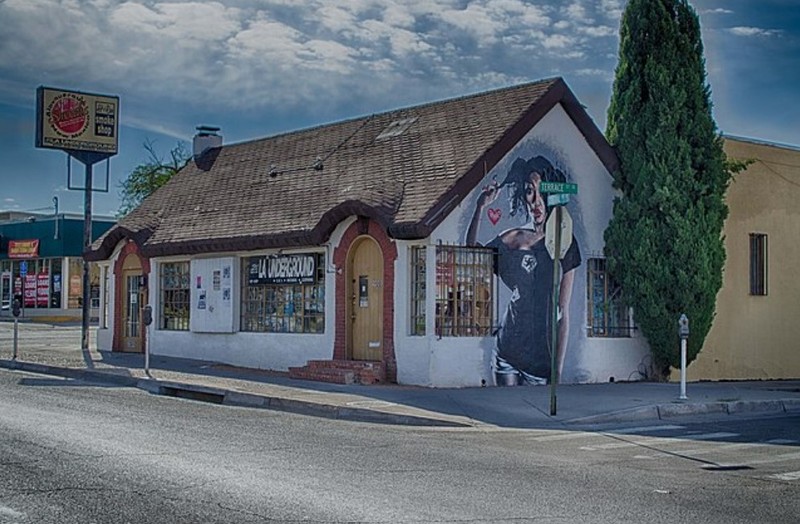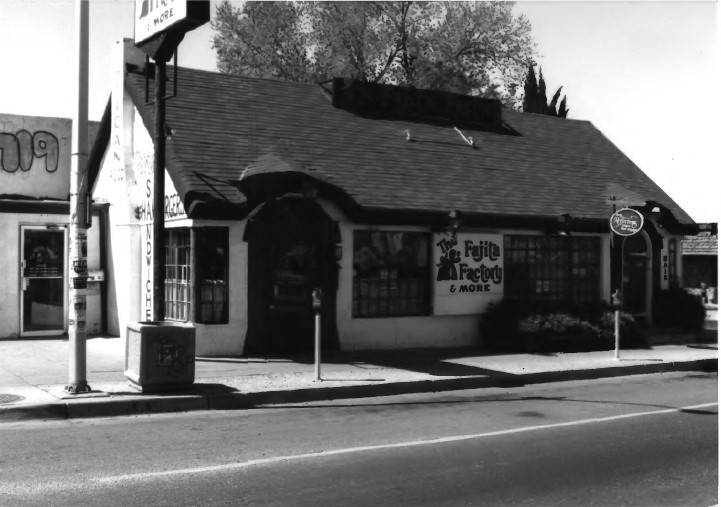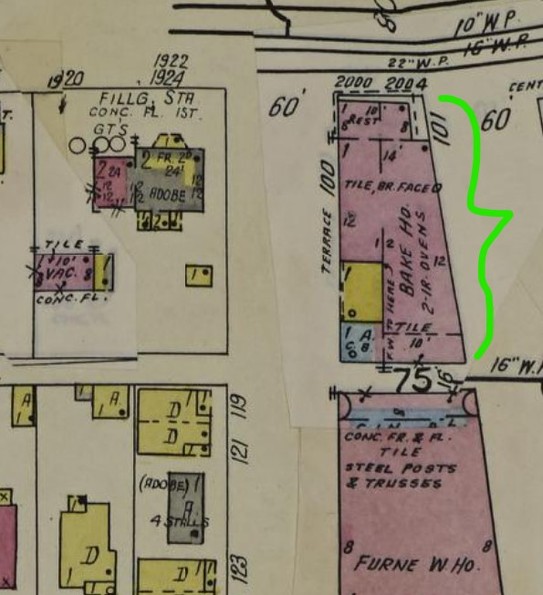Cottage Bakery; Hausammann Brewhaus
Introduction
Text-to-speech Audio
The quaint Albuquerque building began as the Cottage Bakery in 1937, the same year Route 66 was rerouted through Albuquerque to Central Ave. The eyebrow-shaped rooflines above the two doorways were styled after traditional thatched-roof European cottages. The front portion of the building served as retail space for the baked goods on the east side, plus an ice cream shop on the west side, while the rear section was used as the bakery's processing and shipping plant. In 1993, the building was designated a New Mexico cultural property. It was listed in the National Register of Historic Places as a well-preserved example of pre-World War II cafes once prevalent along Route 66. The building has been converted into a pub called Hausammann Brewhaus.
Images
Cottage Bakery housing a smoke shop and LA Underground shop in 2012 photo (Ridgecrest photo)

Fajita Factory & More shop in Cottage Bakery building in early 1990s photo (Kammer for NRHP)

Cottage Bakery (green bracket) on 1951 Sanborn map (p. 52)

Backstory and Context
Text-to-speech Audio
Herbert Weis and Prince Shroeder (his brother-in-law) opened the Cottage Pure Food Shop on Monte Vista Blvd. in Albuquerque in 1931, specializing in wholesale pastry; they had previously run a similar shop in Winslow, Arizona. In the original alignment of U.S. Highway 66 ("Route 66") in 1926, the highway passed through Santa Fe and north/south through Albuquerque along 4th Street. A shorter route across New Mexico was established in 1937, eliminating Santa Fe and instead heading straight across the state from east to west. The new alignment placed Rt. 66 along Central Avenue in Albuquerque. The Cottage Bakery building was constructed to take advantage of the through traffic, plus the location across the street from the University of New Mexico campus. The business moved to the new location in July 1937 on the corner of Central Ave. and Terrace St. SE.
The Thatched Cottage style building for the Cottage Bakery had two sections, in front and back; the front section often housed two businesses, each with their own doorway. The front (north) facade. along the Central Avenue sidewalk, featured eyebrow-shaped rooflines above each of the doors near both ends; the shape plus the brown color of the asphalt shingles were meant to resemble traditional thatched-roof European cottages. Segmented brick arches outlined the arch-shaped doors. An exterior chimney was placed beneath the east gable. Large, multi-light casement windows appeared on the front and west sides of the building and windows wrapped around the corners.
The western front door originally led to the Spot Ice Cream Company on the western part of the front section. Spot Ice Cream specialized in serving locals and travelers along Route 66 either inside at the soda fountain or outside as curb service. The front section housed the Cottage Bakery retail sales on the east side, with the much-larger, rear section used for processing and shipping baked goods. The rear portion was touted in the 1930s as being modern, with up-to-date electric baking ovens and mixing machines, with showers and lockers for employees in the full basement. The Thatched Cottage style was meant to imply purity of the dairy and bakery products.
The Cottage Bakery continued to occupy the eastern front half of the building (2004 Central Ave. SE) until 1960. The Spot Ice Cream Company was gone after a few years, and the western front part of the building (2000 Central Ave. SE) housed a number of businesses in the 1940s, including a cafe, a pharmacy, and a flower shop. In the 1950s, the west front became the Cottage Grill. Both front halves were converted into a men's clothing store, Brennan's Men's Shop, in the 1960s. The halves were split once again in the mid-1960s, with a succession of pizza restaurants (2004 Central) and the Psychedelic Flower Shop (2000 Central).
In the 1980s, part of the front section of the building was a hair salon and part was a restaurant; the rear portion became the home of a live theater company. By the 1990s, the front section of the building was used as a restaurant (The Fajita Factory) and the rear was a playhouse for patrons. The fireplace in the restaurant featured a wooden mantel and a plain tile hearth, when the National Register documentation was done in the early 1990s. A small entry constructed of concrete block with a shed roof was added onto the east side. LA Underground, a hip-hop culture store, opened in 1997 (2000 Central).
Sources
Anonymous. "Cottage Pure Food Shoppe." Albuquerque Progress (Albuquerque) August 1st, 1937. 4-4.
Kammer, David J. NRHP nomination of Cottage Bakery, Albuquerque, Bernalillo County, New Mexico. National Register. Washington, DC. National Park Service, 1993.
National Park Service. Cottage Bakery, Albuquerque, New Mexico, Discover Our Shared Heritage Travel Itinerary: Route 66. Accessed October 17th, 2023. https://home1.nps.gov/Nr/travel/route66/cottage_bakery.html.
https://en.wikipedia.org/wiki/Cottage_Bakery#/media/File:Cottage_Bakery.jpg
National Park Service (NPS): https://npgallery.nps.gov/AssetDetail/NRIS/93001218
Library of Congress (LOC): https://www.loc.gov/item/sanborn05670_011/
